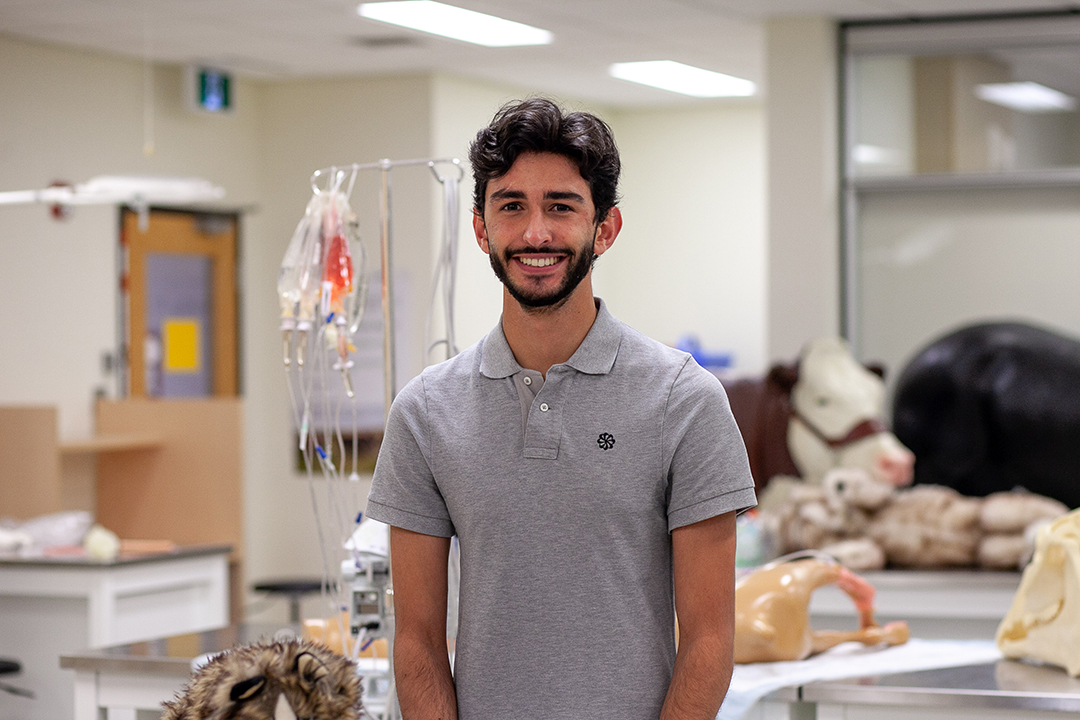
Kenyan student’s love of wildlife led to vet school
While growing up in Kenya, Armaan Bhatia crossed paths with animals of all shapes and sizes.
By Lynne GunvilleBesides his menagerie of dogs, cats, tortoises and other pets, he was regularly called upon to remove bats and snakes from his family’s house as well as one wayward snake that somehow found its way into his mother’s purse.
He also lived just a short distance away from some of the world’s most prized creatures.
“Africa’s more charismatic fauna were only a few hours away from my home,” says Bhatia. “There were many family and school trips taken to the country’s wilder places to spend time amongst elephants, lions and cheetahs.”
Wild animals were an integral part of Bhatia’s culture, and he always knew that he wanted to work with animals — he just wasn’t sure in what capacity.
He did know, however, that he wanted to take his post-secondary education in Canada, specifically the University of Calgary (UCalgary) where his parents had met.
After completing his first year of a Bachelor of Science degree program at UCalgary, Bhatia became a summer intern at the Dr. K.A. Shah Veterinary Clinic in his Kenyan home community of Eldoret. It was a pivotal experience for him. By summer’s end, he knew that veterinary medicine was exactly what he wanted for a career.
While the summer job provided opportunities for Bhatia to work with various small and large animal species, it also gave him a new appreciation for the facilities and equipment that are commonplace at Canadian veterinary clinics.
“Things like X-ray machines, ultrasounds and dental equipment are all fairly standard at practices here,” says Bhatia. “But that’s not the case for most in Kenya. This means that certain ailments are not picked up on as fast as they would be here, and the more complicated surgical procedures that can be performed here are simply not feasible.”
With his career plans confirmed, Bhatia decided to seek more experience in as many veterinary fields as possible. He volunteered at an animal rescue, and he spent time working and volunteering at several mixed and small animal practices. He also volunteered at the Calgary Wildlife Rehabilitation Society where he was eventually hired on as a wildlife technician.
“I had been around wild animals for practically my entire life, but it wasn’t until I moved to Calgary that I was able to begin working with them in earnest,” says Bhatia.
As he spent time raising, rescuing and rehabilitating numerous species of Albertan wildlife, Bhatia relished the chance to work in the unique and often challenging field of wildlife medicine. While he describes the work as both difficult and rewarding, he welcomed any chance to begin developing clinical and professional skills.
Bhatia expanded his wildlife expertise even further when he spent a summer working with UCalgary’s Summer Undergraduate Research Experience (SURE) program. As he helped with a project investigating a procedure for measuring immunological changes in caribou, he particularly enjoyed working with the captive reindeer herd housed at the university.
“I was able to gain further experience in wildlife medicine, this time through a research lens,” says Bhatia. “The reasons I love working with wildlife tie into me growing up surrounded by so many different wild animals … allowing me to understand just how crucial they are ecologically, economically and culturally.”
Bhatia encountered another aspect of research when he spent several months working as an animal care technician at UCalgary. As he cared for and monitored laboratory animals involved in tests relevant to the COVID-19 pandemic, he gained an appreciation for this crucial aspect of veterinary medicine.
Bhatia began his first year of the Doctor of Veterinary Medicine program at the Western College of Veterinary Medicine (WCVM) in August 2021. He’s one of five international students in the college’s Class of 2025.
“As one of the first international students accepted into the WCVM, I am really looking forward to helping the incoming international students who join the program in the future,” says Bhatia. “I definitely want to play a large role in helping to establish a strong, welcoming community for international students here.”
While he has found highlights in every course he’s taken so far, Bhatia particularly enjoyed the clinical skills class and the opportunities it provided to learn and practise practical activities such as suturing and blood draws that help him “keep his eyes on the prize.”
As he considers his future plans, Bhatia is interested in a career that combines wildlife and small animal medicine.
“One veterinarian I worked with managed to work on call for a wildlife centre for a few days a week while still running her own small animal clinic. If I found myself in a similar position five years down the line, I’d be ecstatic,” says Bhatia.
“Wildlife is the reason I fell in love with working with animals, and it’s something I always want to be part of my life.”
